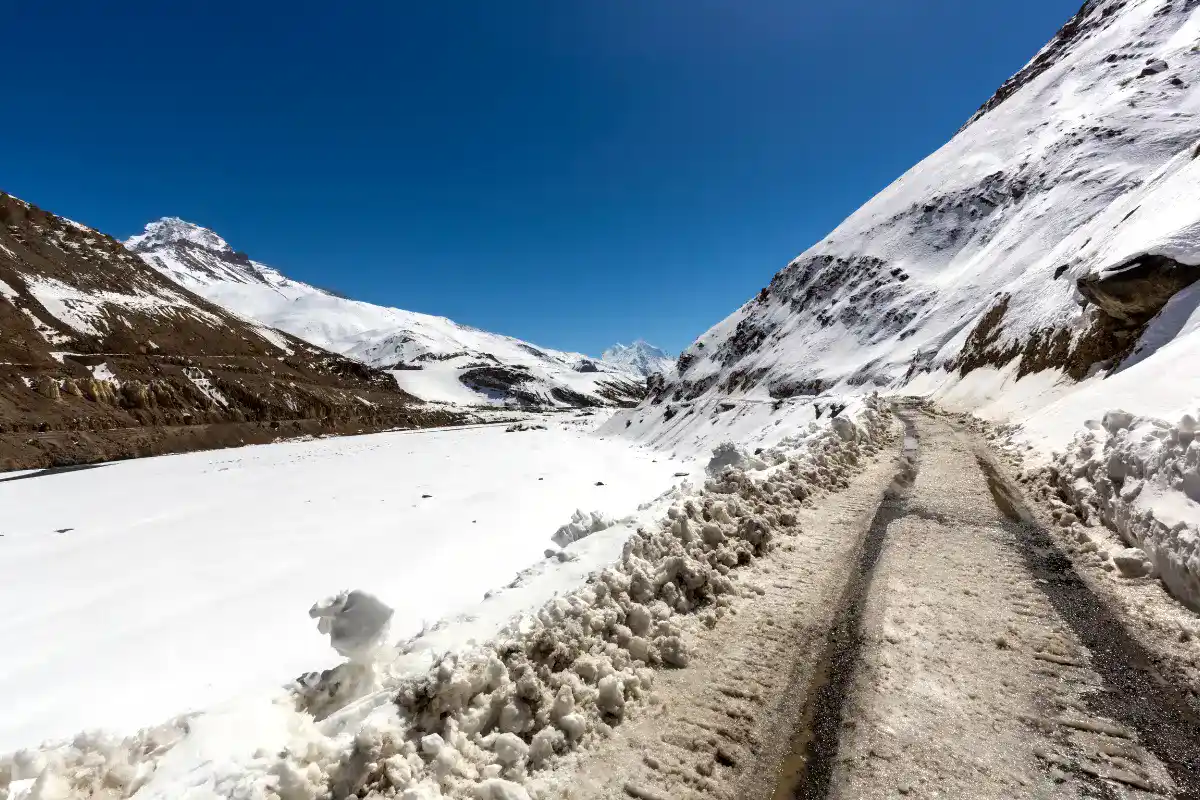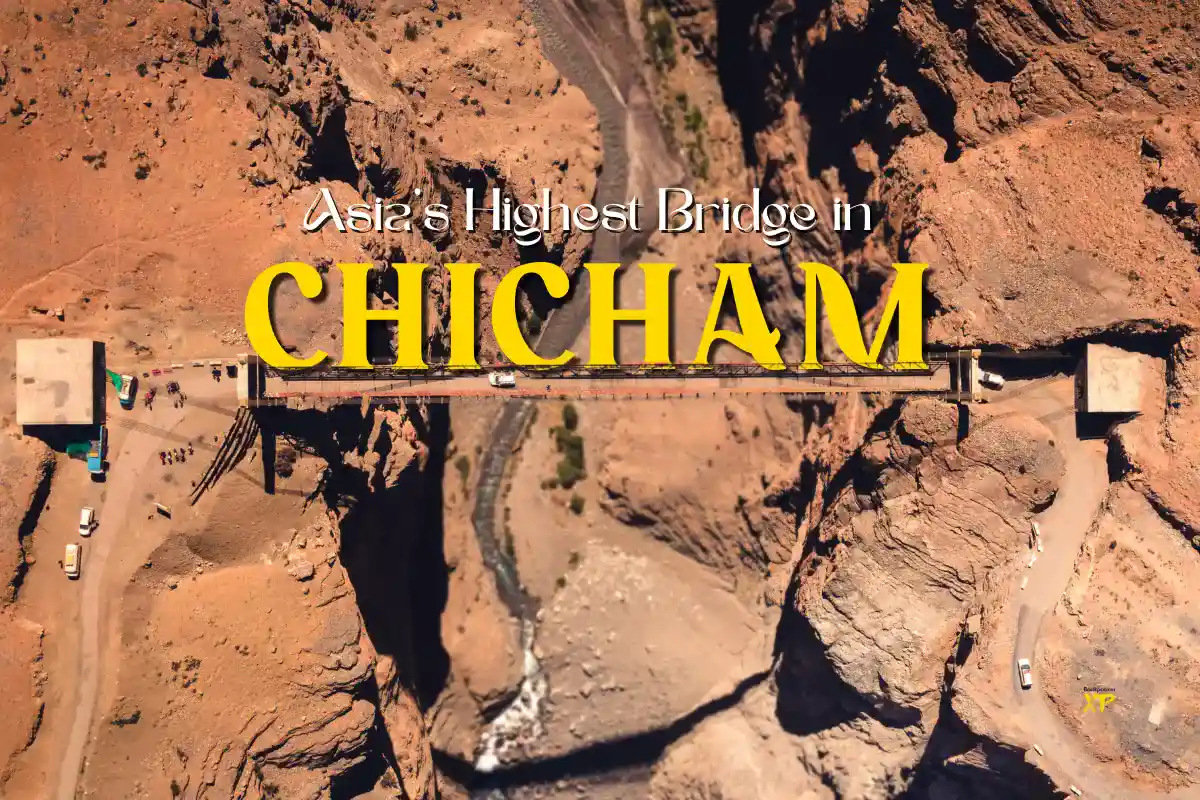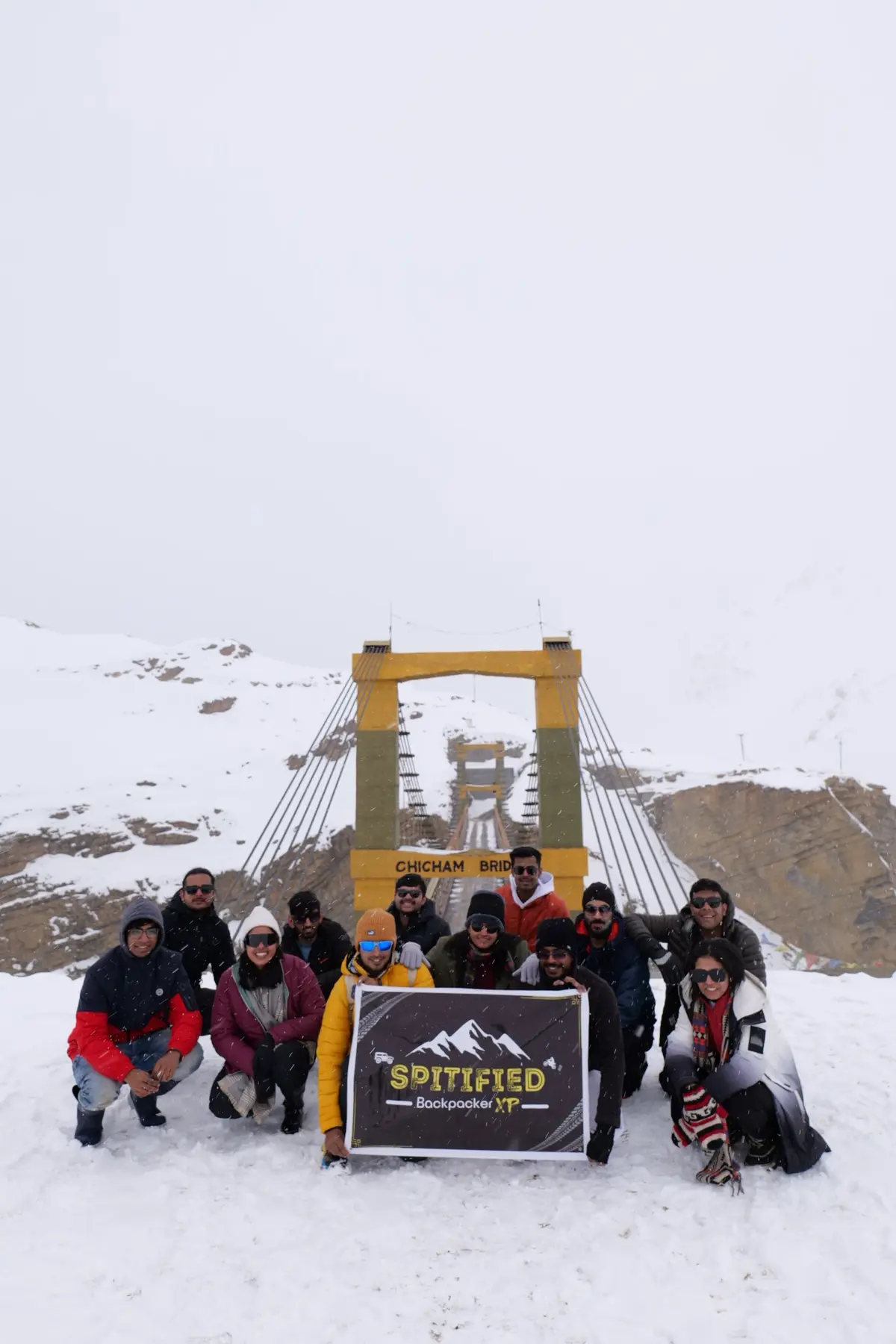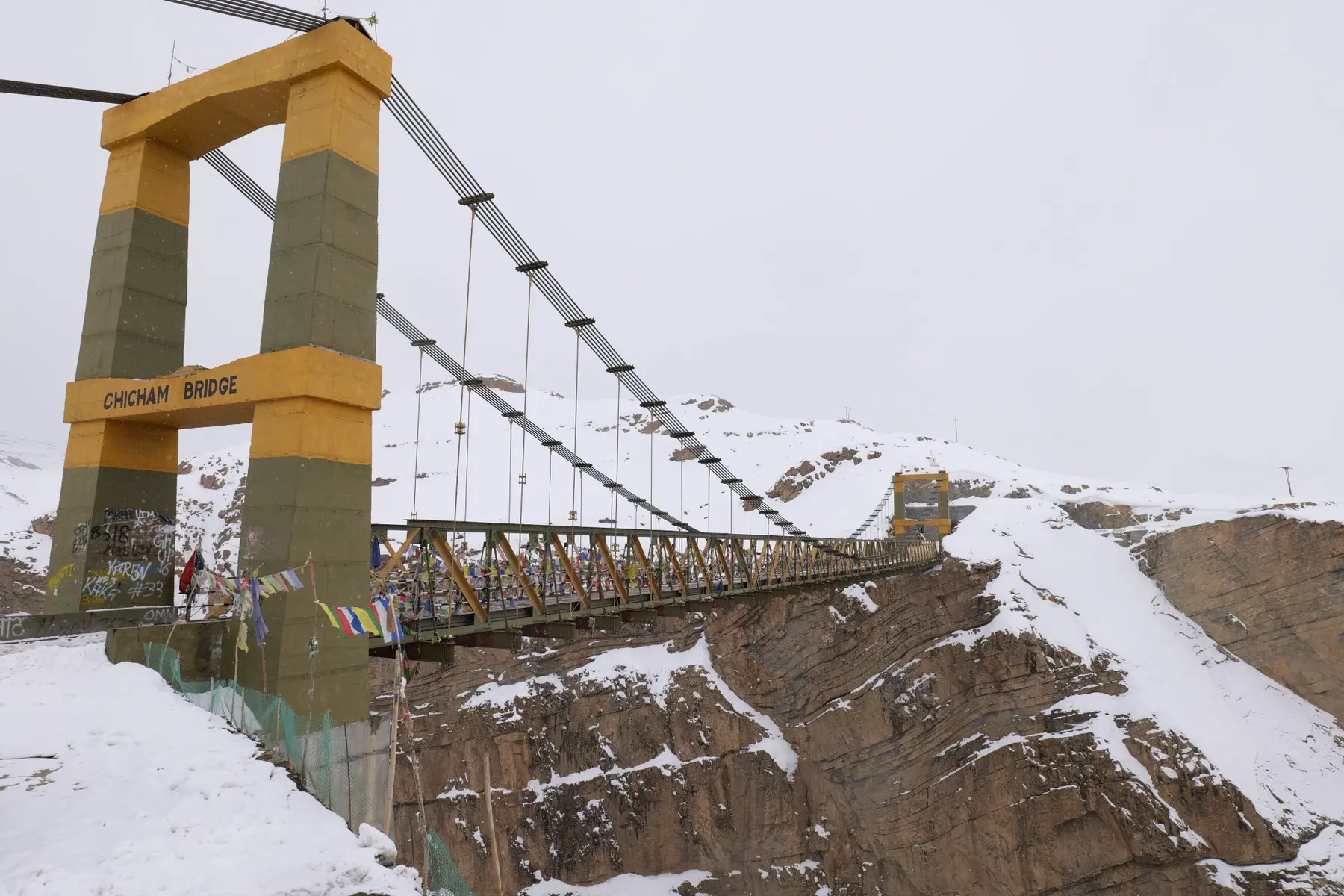Chicham Bridge, Spiti Valley: Conquering Asia’s Highest Suspension Bridge (and the Thrill Beyond!) Dare to cross Chicham Bridge, Asia’s highest suspension bridge in Spiti Valley! Get how-to-reach guides, best time to visit, and essential tips for an unforgettable Himalayan adventure.
Introduction: A Sky-High Symphony in the Himalayas
Imagine standing suspended between two worlds, a thousand feet above a roaring gorge, with prayer flags whispering ancient tales and snow-capped peaks piercing the sky. Welcome to Chicham Bridge.
This incredible structure is Asia’s highest suspension bridge, nestled in the raw, captivating Spiti Valley. It’s a place where engineering meets the sublime, where adrenaline rushes mingle with spiritual serenity.
What can you expect from this guide? Your ultimate roadmap to experiencing this engineering marvel and the hidden gems around it.
Chicham Bridge: Spiti’s Engineering Marvel & Lifeline
A Bridge Built Against All Odds
The story behind Asia’s highest suspension bridge is truly incredible. It’s a tale of human determination conquering some of the most challenging terrain on Earth.
The altitude check reads a staggering 13,596 feet (4,145 meters) above sea level. Below, the Samba Lamba Gorge plunges a breathtaking 1,000 feet.
Before the bridge, locals relied on a perilous “jula” system – a dangerous ropeway. Imagine crossing that with goods in the freezing winters! The Border Roads Organisation (BRO) took on the Herculean task, with 14 years of construction overcoming every obstacle.
More Than Just Steel: Its Impact on Chicham & Kibber Villages
This bridge isn’t just steel and concrete; it’s a lifeline. It connects remote communities, slashing travel time and granting access to essential supplies.
It stands as a symbol of resilience and progress, a testament to the indomitable spirit of the high Himalayas. It has shortened the distance to Losar from Kaza by 40 km.
When to Cross the Sky: Best Time to Visit Chicham Bridge
Planning your visit around the weather is critical in Spiti Valley. The seasons dictate access and experience.
The Golden Window: May to October
This is the prime time to visit. Clear roads, pleasant weather, and sunshine are optimal for photography and exploration.
Expect daytime temperatures ranging from a cool 5°C to a comfortable 20°C. As per locals, this window offers the most predictable conditions.
Winter Wonderland: November to April (For the Daredevils)
Warning: This season is extremely harsh. Heavy snowfall and icy conditions make roads often inaccessible.
This is only for experienced winter travelers with proper gear, guidance, and a high tolerance for extreme cold. Temperatures can plummet far below freezing.
Your Route to the Clouds: How to Reach Chicham Bridge

Getting to Chicham Bridge requires navigating the rugged terrain of Spiti Valley. Here’s what you need to know.
Gateway to Spiti: Kaza, Your Basecamp
Kaza, the main town in Spiti, is your starting point. From Kaza, Chicham Bridge is just 18-20 km away – a scenic 40-minute drive.
Taxis, shared rides, and even local bus services are available from Kaza. A popular option, according to many travel blogs, is renting a motorbike for the day.
The Two Epic Road Journeys to Spiti Valley
There are two main routes to reach Kaza, each with its own charm and challenges:
- The Manali Route (Summer Only): This adventurous route crosses Rohtang Pass and Kunzum Pass before reaching Kaza. Be sure to check for road openings in late May or early June, as per the Himachal Tourism site.
- The Shimla Route (More Reliable, Longer): This route winds through the Kinnaur Valley, Nako, and Tabo before reaching Kaza. It’s generally open for a longer period than the Manali route.
Getting to Spiti: Air & Rail Connections
- The nearest airport is Bhuntar Airport (Kullu). From there, take a road to Manali or directly to Kaza. Be aware that flights can be unreliable due to weather.
- The nearest railway station is Shimla. From Shimla, embark on a scenic road journey to Kaza. This journey is approximately 420 km and can take around 16 hours.
Pro Tip
Always check road conditions before you go – especially for the Manali route! Landslides and sudden closures are common.
Spiti Valley – Travel Guide, Places to visit, Best Time, How to Reach
Beyond the Bridge: Top Experiences & Things to Do Around Chicham
Chicham Bridge is just the beginning. The surrounding area is packed with unique experiences.
Feel the Thrill: Walking (or Driving!) Across Chicham Bridge
Walking or driving across is an absolute must. It’s an adrenaline rush with unparalleled views.
Capture panoramic photography of the gorge, the majestic mountains, and the winding Spiti River below. This is a truly unforgettable experience.
Immerse Yourself: Exploring Chicham & Kibber Villages
- Kibber Village: Just a short distance from the bridge, Kibber is one of the world’s highest inhabited villages. Explore its traditional mud houses and experience the local way of life.
- Chicham Village: Get a taste of authentic Spitian local life and experience the warm hospitality of the villagers.
Spiritual Wonders: Monastery Hopping
Spiti Valley is a treasure trove of ancient monasteries:
- Key Monastery (Kye/Ki Gompa): Spiti’s largest & oldest Tibetan Buddhist monastery. Don’t miss the stunning views and rich history.
- Komic Village & Tangyud Monastery: Visit one of the highest motorable villages and its ancient monastery.
- Dhankar Monastery & Lake: A dramatically perched monastery. Take the challenging trek to a serene lake.
- Tabo Monastery: The “Ajanta of the Himalayas,” a millennium-old complex with incredible murals.
Unique High-Altitude Adventures
- Hikkim: Postcard from the Top: Send a letter from the world’s highest post office. It’s a novelty you can mail.
- Langza: The Fossil Village: Hunt for marine fossils and see the giant Buddha statue overlooking the valley.
- Kibber Wildlife Sanctuary: Spot elusive snow leopards, Siberian ibex (especially in winter).
- Stargazing & Night Photography: Unpolluted skies offer incredible cosmic views.
Life in the High Lands: Spiti Valley’s Local Culture & Lifestyle
Buddhist Roots & Bon Echoes
Spiti’s culture is a unique blend of ancient traditions, primarily Tibetan Buddhism with echoes of the pre-Buddhist Bon religion. You’ll see this reflected in every aspect of life.
Resilience & Warmth
The spirit of the Spitians is remarkable. Their resilience shines through in the face of a harsh climate. They are known for their warmth and hospitality.
Festivals That Ignite the Valley
- Losar (Tibetan New Year): Witness masked ‘Chham’ dances and vibrant celebrations.
- Ladarcha Fair: A historic trade fair turned cultural extravaganza in Kaza.
Traditional Architecture
The architecture is adapted for survival and spirituality – mud-brick homes, prayer flags, and chortens dotting the landscape.
Fueling Your Adventure: Stay & Food Options Near Chicham Bridge

Authentic Homestays in Chicham & Kibber
- Experience local hospitality in places like Tara Homestay, Tethys Himalayan DEN, and Pema’s Cottage.
- Expect basic amenities, home-cooked Spitian meals, and a direct way to support the community.
Comfort & Choices in Kaza
Kaza offers hotels, guesthouses, and cafes for varied preferences. It’s a good place to recharge and find more options.
Must-Try Traditional Spitian Food
- Thukpa: Hearty noodle soup to warm your soul.
- Momos: Steamed dumplings with flavorful fillings.
- Tsampa: Roasted barley flour – the energy boost of the Himalayas.
- Skyu: Handmade pasta-like noodles with root vegetables.
- Butter Tea (Po Cha): Salty, creamy, and essential for hydration at altitude.
- Chhurpi (dried yak cheese), Chhang (barley brew), Seabuckthorn juice.
Your Spiti Survival Kit: Essential Travel Tips & What to Pack
Acclimatize Like a Pro
Spend 1-2 days in Kaza before venturing to higher altitudes. This is crucial to prevent altitude sickness.
Layer Up, Always
Temperatures can drop fast, even in summer. Be prepared for anything.
- Thermals, fleece, down jacket, waterproof outer shell.
- Woolen cap, gloves, warm socks.
Footwear
Sturdy, waterproof trekking shoes with good grip are essential.
Carry Essentials
- Cash (ATMs are rare, card payments minimal).
- Reusable water bottle (stay hydrated!).
- High-energy snacks.
- Basic first-aid kit (especially for AMS).
- Sunscreen, sunglasses, lip balm (high UV).
Connectivity
Mobile network is limited. Download offline maps for navigation.
Respect & Responsibility
Embrace local customs and minimize waste. Leave no trace behind.
Road Ready
A sturdy vehicle (SUV/4×4) and an experienced driver are recommended for navigating the rough roads.
Adventure Continues: Nearby Places & Day Trip Ideas from Kaza
- Pin Valley National Park: Explore unique flora and fauna, and go snow leopard spotting.
- Chandratal Lake (Moon Lake): A stunning crescent-shaped lake. Camping opportunities are available (seasonal).
- Kunzum Pass (Kunzum La): A high-altitude pass with incredible views, and the gateway to Lahaul.
Weather Watch: Understanding Spiti’s Extreme Climate
Cold Desert Environment
Spiti Valley is characterized by its unique geography of barren mountains and deep valleys, a cold desert environment unlike anywhere else.
Temperature Ranges
Expect extremes, from -30°C in winter to 20°C in summer.
Monsoon Season (July-August)
Be aware of the risk of landslides and potential road closures during the monsoon.
Unpredictability
Be prepared for sudden weather changes anytime. Pack accordingly and stay informed.
Why BackpackerXP for Your Chicham Bridge Adventure?

We don’t just take you places; we immerse you in stories. Our Spiti trips connect you with local life, from homestays to hidden trails.
Our expert local guides, responsible travel practices, and a community of like-minded young explorers are waiting to share the thrill.
Experience Chicham Bridge not just as a landmark, but as a living piece of Spiti’s soul.
FAQs: Your Burning Questions About Chicham Bridge Answered
Is Chicham Bridge safe to cross?
Yes, Chicham Bridge is structurally sound and safe for both pedestrians and vehicles. However, exercise caution, especially during windy conditions.
What is the height of Chicham Bridge?
Chicham Bridge stands at an altitude of 13,596 feet (4,145 meters) above sea level.
Can cars cross Chicham Bridge?
Yes, cars and other vehicles can cross Chicham Bridge, but exercise caution and adhere to weight restrictions.
Are there any entry fees for Chicham Bridge?
No, there are no entry fees for Chicham Bridge.
How far is Chicham Bridge from Kaza?
Chicham Bridge to Kaza distance is approximately 18-20 kilometers from Kaza, a scenic 40-minute drive.
What are the alternatives if roads to Spiti are closed?
The Shimla-Kaza route remains open year-round, but when it closes due to heavy snow, the BRO opens it as soon as possible. So, if roads to Spiti are closed, the only alternative is to wait for them to reopen.
Is acclimatization necessary for visiting Chicham Bridge?
Yes, acclimatization is highly recommended due to the high altitude. Spend at least a day or two in Kaza before visiting Chicham Bridge.
Conclusion: Your Spiti Adventure Awaits
Chicham Bridge is more than just a bridge; it’s a symbol of human endeavor amidst the grandeur of the Himalayas. It’s a place that stays with you long after you’ve crossed it.
Ready to stand on top of Asia’s highest bridge and unravel the mysteries of Spiti Valley? Explore BackpackerXP’s curated Spiti trips and let’s make memories that last a lifetime!Message us on WhatsApp at +91 8005729115 to join our next BackpackerXP experience.



0 Comment